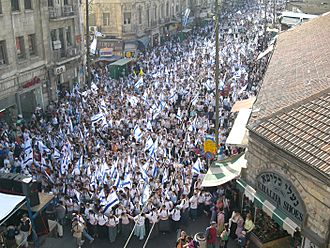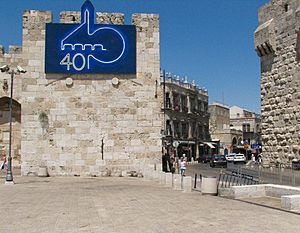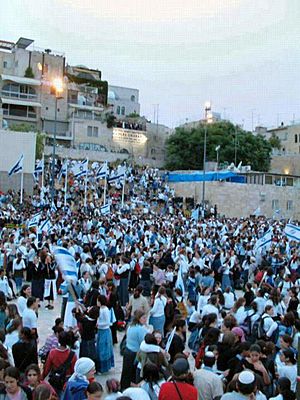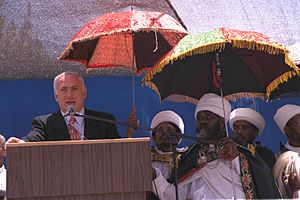Jerusalem Day facts for kids
Quick facts for kids Jerusalem Day |
|
|---|---|

The Israeli Dance of Flags at Jaffa Road, 2007
|
|
| Official name | יום ירושלים (Yom Yerushaláyim) |
| Observed by | Israelis, Jews |
| Type | National |
| Significance | Marks the reunification of East Jerusalem with West Jerusalem under Israel; the first time the whole city came under Jewish rule since the destruction of the Second Temple in 70 CE during the Jewish–Roman wars |
| Celebrations | Dance of Flags |
| Date | 28 Iyar (Hebrew calendar) |
| 2025 date | Sunset, 25 May – nightfall, 26 May |
| 2026 date | Sunset, 14 May – nightfall, 15 May |
| 2027 date | Sunset, 3 June – nightfall, 4 June |
| 2028 date | Sunset, 23 May – nightfall, 24 May |
| Frequency | Annual |
| First time | 12 May 1968 |
Jerusalem Day (Hebrew: יום ירושלים, Yom Yerushaláyim) is an Israeli national holiday. It celebrates the "reunification" of East Jerusalem with West Jerusalem. This happened after the Six-Day War in 1967. During this war, Israel took control of East Jerusalem.
The holiday is celebrated every year on the 28th day of Iyar in the Hebrew calendar. There are official ceremonies and special services across Israel. A well-known celebration is the Dance of Flags parade. The Chief Rabbinate of Israel sees Jerusalem Day as a minor religious holiday. This is because it marks the return of Jewish people to the Western Wall.
Contents
How Jerusalem Became One Again
A Divided City

After World War II, the United Nations Partition Plan for Palestine was created in 1947. This plan suggested creating two states: one for Jewish people and one for Arabs. Jerusalem was meant to be an international city. This meant it would not belong to either group. Jewish leaders accepted this plan, but Arab leaders did not.
A civil war began in 1947. It led to the 1948 Arab–Israeli War in 1948. During this war, Jordan took control of East Jerusalem and the Old City. Israel took the western part of the city. The war ended with Jerusalem divided by the Green Line.
Under Jordanian rule, Jewish people were forced out of East Jerusalem. Many synagogues were destroyed. The Jewish cemetery on the Mount of Olives was damaged.
The Six-Day War
In 1967, the Six-Day War took place. Israel captured East Jerusalem and the West Bank from Jordan. This happened on June 7, 1967. On that day, Defense Minister Moshe Dayan made an important statement. He said that the Israeli army had "liberated Jerusalem." He also said that Jerusalem, the capital of Israel, was now united. He promised religious freedom to Christians and Muslims.
The war ended on June 11, 1967. Israel was now in control of all of Jerusalem. On June 27, 1967, Israel expanded the city's borders. On July 30, 1980, the Knesset (Israel's parliament) passed the Jerusalem Law. This law officially declared Jerusalem as the complete and united capital of Israel.
How Jerusalem Day is Celebrated
Becoming a National Holiday
On May 12, 1968, the Israeli government announced a new holiday. It was called Jerusalem Day. It would be celebrated on the 28th of Iyar. This was the Hebrew date when Jerusalem became one city again. On March 23, 1998, the Knesset passed a law making Jerusalem Day a national holiday.
One of the main ideas of Jerusalem Day comes from the Psalms. It says, "Built-up Jerusalem is like a city that was joined together" (Psalm 122:3).
Special Events

In 2007, Jerusalem Day marked 40 years since the city's reunification. The slogan for that year was "Something Special for Everyone." To celebrate, the road leading to Jerusalem was lit up with blue lights.
Since 2015, Yad Sarah, a volunteer group, has organized special tours. These tours are for people who use wheelchairs. They focus on Jerusalem's history. The "Worthy Citizen of Jerusalem" prize is given out every year on Jerusalem Day. The Jerusalem municipality awards this prize.
50th Anniversary Celebrations
In 2017, Jerusalem Day celebrated its 50th anniversary. Many events took place throughout the year to mark this special milestone. The main idea of these celebrations was the "Liberation of Jerusalem."
The celebrations started during Hanukkah in 2016. An official ceremony was held at the City of David National Park. During this event, an ancient "Pilgrims' Route" was shown. This path led from the City of David to the Temple Mount long ago.
Importance of Jerusalem Day

Jerusalem Day is mostly celebrated in Israel. For most non-religious Israelis, it has become less important. However, it is still very important for Israel's Religious Zionist community. They celebrate with parades and special prayers in synagogues.
Religious Practices
Religious Zionists say special holiday prayers, including Hallel. Some rabbis believe it is important to say these prayers. Other Jewish groups, like some Haredim, do not observe Jerusalem Day. They do not see the State of Israel as having religious meaning.
In 2015, a special prayer book was published. It was made for observing Jerusalem Day and Independence Day.
Ethiopian Jews' Memorial Day
A ceremony is held on Jerusalem Day to remember Ethiopian Jews. These individuals died while trying to reach Israel. In 2004, the Israeli government made this a state ceremony. It is held at a memorial site on Mount Herzl.
See also
 In Spanish: Yom Yerushalayim para niños
In Spanish: Yom Yerushalayim para niños


